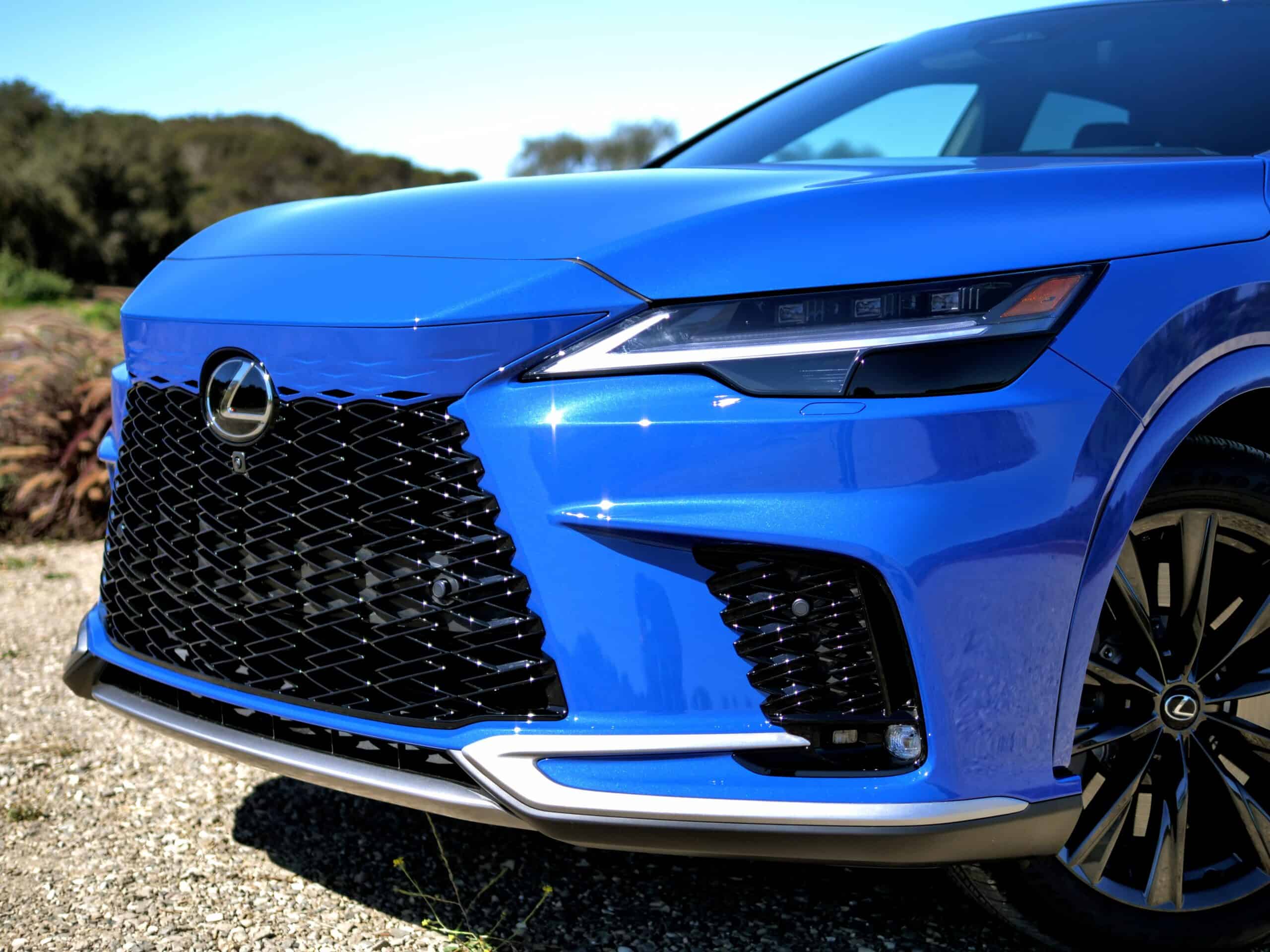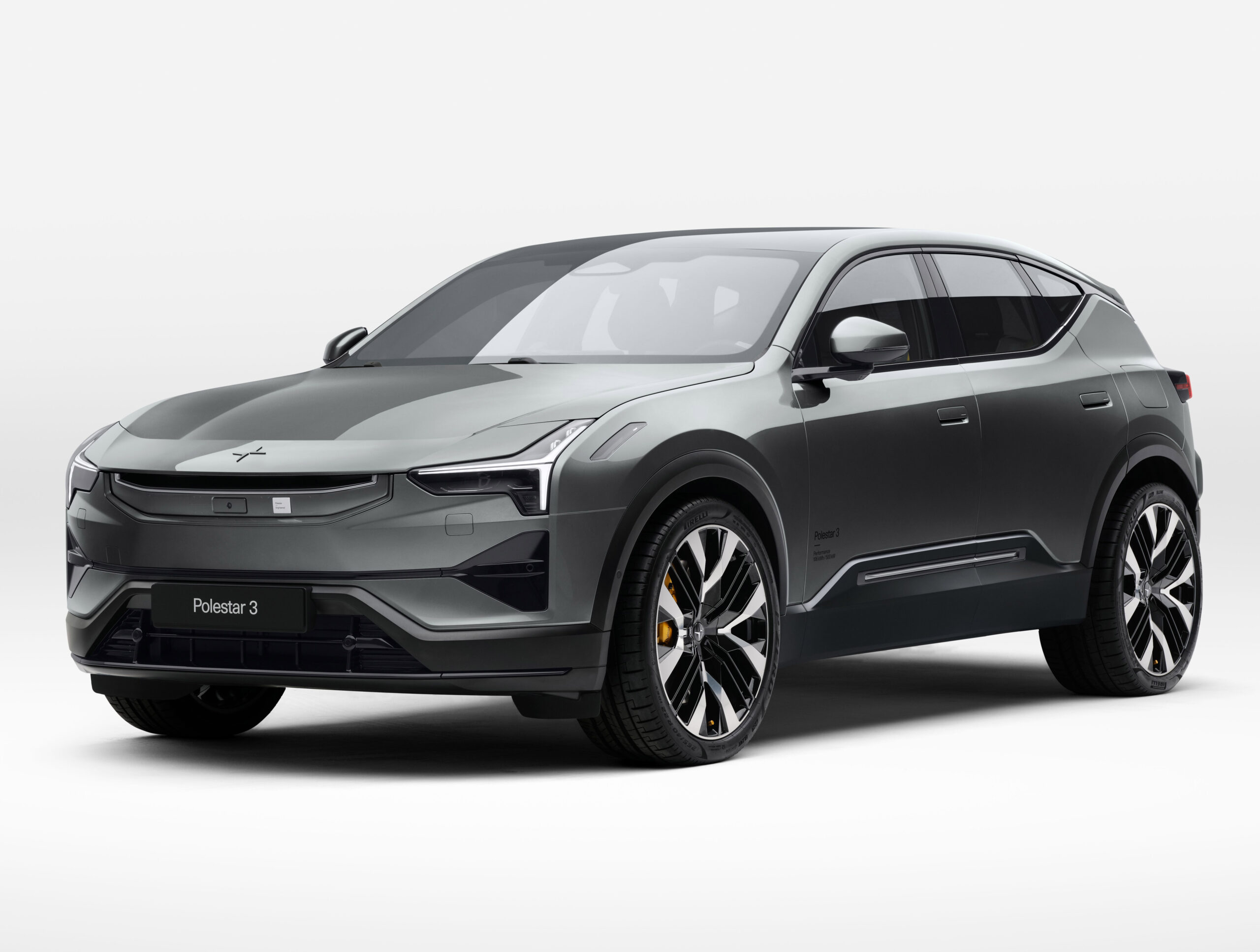

2023 Lexus RX First Drive: Lexus and Mercedes-Benz can both be credited with creating the luxury SUV category back in the late 1990s. Where Mercedes’ entry, the ML (now GLE) was a bubbly-looking body-on-frame SUV with optional 4WD and V8 engines, Lexus’ RX was a unibody crossover based on the Japanese market Harrier with a V6 and optional AWD. Calling that formula a success is putting things mildly, last year the RX alone represented more than a third of all Lexus sales in the USA.
Over the years Lexus has tweaked the formula here and there with a segment-first hybrid system, an optional (and un-usable) third row, but its mantra always remained the same: straddle the line between luxury sedan and SUV. As such, RX has always been known for its smooth powertrains, supple ride, and comfortable interior. For 2023, Lexus has given it the biggest update it has ever received. No more V6, no more third row option, and not one, not two, but three hybrid powertrains. So, is the fifth generation 2023 Lexus RX a successful change of pace for the brand’s most popular model? Find out here.
Evolution, not revolution is the theme for the new RX. Park it alone and you’d be forgiven for thinking nothing had changes, but park it next to the outgoing model and you’ll realize that the only thing shared is the unique D-pillar “floating roof’ design. The most significant styling change happens on the front bumper. The controversial spindle grille has been rethought, and is now referred to as the ‘spindle body’. Instead of outlining the grille with a prominent chrome border, Lexus designers made the edges fade into the body via visual trickery. The top portion as well as some areas of the middle of the grille, depending on which trim you get, are body-colored. If you get an F Sport model, the lower grille has a gloss black chain-linked fence design, while the rest have solid elements with a lighter treatment.
Wheel sizes range from 19″-21″, and the wheelbase has been stretched by 2.36 inches. Lexus shaved an equal 2.36 inches off of the rear overhang, but the RX’s hallmark long front overhang remains. The body is 0.4 inches shorter and the A-pillars were pushed back a bit to give this one a more wagon-like stance. The hood is long, the grille upright, and the rear tailgate steeply-raked. This is the best-looking RX they’ve ever made, to our eyes. One polarizing change that has already made its way to the NX and LX is the L E X U S name spelled out across the tailgate. Some find that it cheapens the look, we think it is pretty elegant. Thankfully, the three-row RX L with its awkward proportions is gone, soon to be replaced by an all-new standalone three-row model. Stay tuned for that…
Inside the 2023 Lexus RX, the old Enform interface and its cumbersome trackpad have been banished. The new driver-focused dashboard features a standard 8-inch or an optional 14-inch touchscreen, which is impressive in the flesh. The new software features voice control, internet connected navigation, and wireless Apple CarPlay/Android Auto. An optional panoramic moonroof and head-up display are new to the model and help bring it in line with the gadget count found in the competition. If you’re a lover of wood trim, a long hallmark of the RX, you may be disappointed as this model has the least amount of tree ever seen in an RX cabin.
In an odd twist that is plaguing the new Lexus lineup, the instrument cluster is only 7 inches in size, while Toyota offers a larger 12+ inch screen on Tundra, Sequoia and Crown. Otherwise, this interior is a nice improvement overall. The driving position actually feels a little sportier due to the lower and longer shape, and rear seat space is perfectly fine. As of this writing, interior dimensions have not been provided besides the cargo space with second row folded – around 34 cubic feet. Not class leading, but this isn’t a boxy vehicle by any means, so we aren’t surprised.
Here is where the 2023 Lexus RX gets interesting. Once the 2024 model year rolls around, there will be four powertrains on offer and none of them will be a V6. Let’s check out the drivetrains one at a time.
The loss of the RX’s V6 is sure to offend some Lexus traditionalists, but what the RX loses in “naturally-aspirated buttery goodness,” it gains in usable power delivery. The new 2.4L turbocharged 4-cylinder engine is shared with the NX and cranks out 275 horsepower (20 less than the old 3.5) and 317 lb.-ft. of torque (49 more than the old V6). The new turbo may not be as refined as the old V6, but because all 317 lb.-ft. of twist happen at a low 1,700 RPM and hang out to 3,600 RPM, you’re unlikely to miss ye olde 3.5L V6. The Aisin 8-speed automatic from last year has been updated for use with the new 2.4L engine, and the combination should net you 25 MPG combined in FWD guise, 24 MPG if you select the optional AWD system.

RX 350
Want sportier styling? As before, an F Sport trim will be offered on AWD models. Although still erring on the side of comfort, the F Sport Handling pack adds an adaptive variable suspension to help firm things up when you want it, beefier brakes up front and a barrage of sporty styling bits. Extra grip? Maybe. The tire width for all RX models is 235 mm, but tire compounds do change from trim to trim.
Every other powertrain going forward for the 2023 Lexus RX is AWD-only and hybrid-only, each with their own distinct missions. The first is essentially the same 2.5L 4-cylinder hybrid system found in the Lexus NX. Producing 246 horsepower and 233 lb.-ft. of torque, the system is far less peppy than the old RX 450h, but fuel economy leaps to 36 MPG combined. As with the hybrid system in the NX, power is sent to the ground up front via a two-motor planetary power split hybrid system, while a separate electric motor handles the rear axle. Rather unfortunately, Lexus has decided to share less technical information about their new hybrid systems than they have in the past, so we’re not sure about the rating of the rear motor. It appears to be around 54 horsepower, according to third party sources.

RX 350h
As you might imagine, the new RX hybrid is less peppy than the old model out on the road. Lexus estimates the RX 350 turbo is good for a 7.2 second sprint to 60, while the RX 350h hybrid stretches that out to 7.4 seconds. Not bad. Dynamically, the hybrid and gas models are quite similar. Lexus’ hybrid system is quiet and unobtrusive around town, but if you’re driving aggressively, the engine will hang out at high RPMs. Likely for cost and complexity reasons, Lexus continues to use a Nickel-Metal Hydride battery in the RX hybrid. Why? Well, with Lithium-Ion battery costs rising and the reality that a liquid cooled Li-Ion pack might save space, the cooling loops and coolant would actually likely weight the same as the less-dense NiMH pack.
Thanks to the updated hybrid design, the RX 350h AWD tips the scales just 143 pounds heavier than the turbo model. The slight increase in weight is largely unnoticeable on the road and although we could not test the two models on a skidpad or do any official instrumented testing, the RX hybrid is likely going to perform similarly to the base model. Want a sporty hybrid? You’ll need to jump up to the RX 500h because Lexus says there will be no F Sport packages available for the 350h.
Lexus is being tight-lipped about the new RX PHEV, but it’s safe to say the 450h+ will be powered by the same system found in the NX 450h+. That means the same 2.5L 4-cylinder hybrid system from the 350h, but with a larger lithium-ion battery and a plug. In the smaller NX, this system makes 304 horsepower and delivers an electric-only range of 37 miles. The RX totals are unknown, but our bet is that it’ll be close to the same. It’s also likely to get the same 6.6 kW onboard charger. Lexus says that details will be released closer to this 2024 model’s on-sale date next year. Luckily, you can also check out the soon-to-be-released European market RX PHEV for details, because it will be essentially the same system. Here is a quick first look.
Speaking of that European spec model, Lexus flew out a pre-production RX 450h+ from Europe for us to take on a quick spin. The drivetrain operates much like the NX 450h+ with four self-explanatory modes: EV, Hybrid (charge reserve), Auto, and Charge. As with the NX PHEV, the RX we drove will allow you to stay in EV-only mode even if you press the accelerator to the floor. So if you’re looking for a PHEV that will do everything it can to stay in EV mode, this one’s for you. Bear in mind, however, that 0-60 times are likely going to stretch out to 10 seconds in this mode. If you think a Leaf is slow, EV mode in an RX PHEV will take 20-30% longer to get to highway speeds.
The halo model in the 2023 Lexus RX lineup gets a brand-new hybrid powertrain. Shared only so far with the upcoming Toyota Crown (where it is known as ‘Hybrid Max’), this hybrid is more focused on performance than efficiency. It’ll still net you 27 MPG combined, however, making it one of the most efficient luxury midsize CUVs. How does it work? Let’d deep-dive.
First, throw out everything you know about Lexus hybrids up till now. The heart of the system is the same 2.4L turbo from the RX 350, producing essentially the same amount of power. The engine is mated to a 6-speed Aisin automatic with an integrated starter/generator. Why only six speeds? Two likely reasons: space and motor torque. It’s likely that removing the lowest two gears were necessary to fit the motor in the same housing, and thanks to electric motors having stout low-end torque, the lower gear ratios found in the RX 350’s 8-speed are less important. If this design sounds similar to BMW, Volvo, and Mercedes PHEVs, you’re on to something. Powering the rear wheels is a new ‘eAxle’ Lexus has dubbed QA10. As with the other hybrid systems, specs are scarce. It would appear that the new rear motor is good for around 90 horsepower thanks to this math: The 2.4L turbo makes 275 HP, the system total is 366 HP, so 91 HP is coming from the motors and the battery. But the devil is in the details and Lexus won’t say how much electric boost will come from the ISG in the transmission housing. Either way, the RX 500h is the most powerful and fastest RX ever created.
Lexus calls the new eAWD system “Direct4”, but the term is a bit more than just the new motor and reduction gear on the rear. Direct4 combines brake-based stability control profiles with tweaked regeneration profiles for the front and rear motor and in-corner brake applications to correct yaw motions. Depending on vehicle speed and throttle position, torque can be split from 70/30 F/R to 20/80, although the latter only under the most specific of situations.
How fast is that? Well, not as fast as an XC90 or X5 PHEV, despite the similar design. Lexus is currently quoting 5.9 seconds 0-60. What’s going on? It’s likely the battery. The RX 500h uses (at least for now) a similar NiMH battery as the RX 350h. Due to the capacity, discharge, and cooling limitations, it’s unlikely Lexus can draw as much power as consistently from the pack as the Volvo and BMW can from their much larger liquid-cooled Li-Ion packs. The benefit for the Lexus design is likely cost and complexity with a dollop of Lexus reliability.
F Sport Performance is Lexus’ new term for a vehicle with extra shove and some handling improvements, but tweaks that aren’t as complete as a full-on F vehicle (think RC F, IS F, etc.). Upgrades over the rest of the RX line include six-piston brake calipers, 21-inch wheels, grippier tires, an adaptive suspension, and rear wheel steering. The rear wheel steer system not only makes the RX 500h easier to park, it can improve handling on your favorite winding road by reducing understeer.

RX 500h F Sport Performance
In our day of testing. the 5.9-second 0-60 time claimed by Lexus seemed about right. The 4-cylinder sound track is basically the same as the RX 350, with the addition of a digital soundtrack played over the car’s speakers. Unlike the first generation NX, Lexus doesn’t seem to offer a way to disable the “augmented” engine sounds, although the amount of augmentation varies with the drive mode. A notable omission on the new performance model? Wider tires. Although the 500h models we tested had Pilot Sport 4 SUV tires (a significant upgrade from the base tires) they were the same 235 mm width as the rest of the lineup. Factor in the extra 529 pounds of curb weight vs a turbo AWD model, and you’ll find that despite the trick four-wheel steering system and adaptive suspension, actual grip is substantially similar to a base RX. It’s clear that Lexus wasn’t interested in alienating the RX clientele by creating a fire-breathing RX. Case in point: the suspension tuning. Even in the RX 500h’s firmest suspension mode, it’s notably softer than the base suspension tunes in most of the European competition. This isn’t Lexus’s attempt at creating a Mercedes-AMG GLE 53, or even an MDX Type S. The mechanical AWD system in the Acura will send notably more power to the rear at higher speeds and just about everything in the segment is shod with wider rubber.
The 2023 Lexus RX is a solid improvement over the outgoing model. With a ton of engine options and multiple personalities to choose from, it doesn’t seem like you can go wrong with any of them. We don’t know how much it will cost compared to its predecessor, among other details. We do know that the 350, 350h and 500h will all go on sale at the end of this year and will be built in Canada and Japan. We don’t know exactly where the 450h+ will be built or when it will go on sale (it will be a ’24 model), but it should be very similar to its NX sibling. If you were hoping the RX driving experience would be massively different this time around, the 2023 model might let you down. This one finely-tunes the dynamics while keeping comfort at the top of the list of priorities. If you were looking for a modern take on the classic formula with new design elements and better tech and powertrains, then the new 2023 Lexus RX has certainly succeeded.



